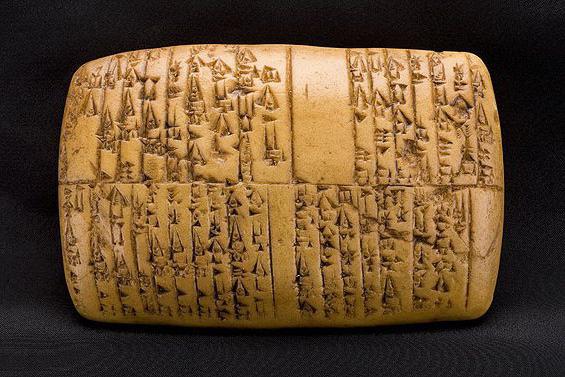The background to the emergence of writing is rooted in the primitive communal system. It was then that people began to develop skills to transmit a variety of messages using drawings. A little later, a man came to the convenience of depicting concepts in writing in the form of combinations of sounds, which, in turn, denoted letters. So the ancient alphabets appeared. Where and how was the first word recorded? What is the drawback of the oldest alphabet and how did you manage to overcome it? Let's try to figure it out ...
Sumerian cuneiform
The first system of written signs, according to historians, arose about five and a half thousand years ago in the agricultural settlements of the Sumerians - the people who lived between the Tigris and Euphrates rivers . The writing method, called "cuneiform writing," consisted of extruding characters on a rectangular tile of wet clay using a sharpened stick, which was held at a slight angle. Next, the tile was dried in the sun or burned in an oven.

Using cuneiform signs, the Sumerians conveyed the meaning of concepts in a stylized form. In addition, they also had designations for some abstract quantities ("light", "time"). In total, there were more than two thousand characters in the picturesque letters. However, to reflect the meaning of complex concepts, there were few of them, so the phonetic principle was introduced by Sumerians. The sign that was associated with a particular sound could be used to indicate another object by that sound. This principle formed the basis of the writing of our days.
Hieroglyphic writing of ancient Egypt
Writing in Egypt arose in the fourth millennium BC. Initially, the recordings were made using conditional images - ancient alphabets appeared in the next stage.
Ancient Egyptian writing united several varieties:
- hieroglyphic - the earliest form of writing of the Egyptians. It was based on the use of pictures, or pictograms; thus composed predominantly religious texts;
- hieratic - a simplified form of hieroglyphic writing. It was a kind of "cursive", convenient for conducting legal and business documents;
- Demotic - a much later and more convenient form of business cursive, the icons of which bear little resemblance to the old hieroglyphs.
However, in all cases of Egyptian writing, a common feature was inherent in which one separate sign could mean a whole concept, a syllable, and a separate sound. In addition, there were also special icons - determinatives that serve to further clarify the meanings of a particular image.
With the help of hieroglyphs, as a rule, monumental inscriptions on stones were carved. Hieratics and demotics made ink on the reed papyrus.
Phenicia or Seir: who first invented the alphabet
The greatest achievement in the field of writing development was the invention of the first alphabet. According to the prevailing theory, the Phoenicians were its creators. For the convenience of conducting trade with peoples speaking different languages, for the first time in the 11th – 10th centuries BC, they implemented the alphanumeric system of recording concepts.
However, there is a second version of the origin of the first alphabet. His invention is attributed to the inhabitants of Seir - a desert area located south of the Dead Sea. It is known that the Seyrians spoke their own language. As early as the 19th century BC, the Egyptians, who equipped expeditions to the Sinai Peninsula, hired them to increase the number of their troops. It is believed that the records made by Seyrsk overseers and forefathers and received by the Egyptians in the form of reports, eventually led to the emergence of the alphabet. Proponents of this theory claim that the earliest recordings using alphabetic characters were made precisely by the inhabitants of Seir.
Phoenician letters. What is the drawback of the ancient alphabet
The Phoenician alphabet includes twenty-two letters. Some signs were borrowed from existing writing systems: Egyptian, Cretan, Babylonian. All the letters of the ancient alphabet were depicted in the form of a conditional diagram of the subject, the name of which began with the sound corresponding to this letter. There was a principle of correspondence of the style of each letter, its pronunciation and name. It is known that the Phoenicians wrote from right to left.
What is the drawback of the oldest alphabet? First of all, in that he depicted only consonant and half-vowel sounds. Vowels simply dropped when writing.
Subsequently, the ancient Phoenician alphabet became the basis on which all the other alphanumeric systems arose, including in Europe.
Greek is one of the oldest living written languages
The starting point for the development of all Western alphabets was the writing of the ancient Greeks. By 403 BC, they had invented a writing system called the "Ionic writing." The Greek alphabet originally had twenty-four letters. The first inscriptions in this language discovered by archaeologists were carved in stone or painted on ceramic objects.
What is the disadvantage of the ancient Greek alphabet? The very first inscriptions that reached us were characterized by letters that have strict geometric shapes and the same exact distance between the lines and individual letters.
Later texts, already handwritten, are characterized by more rounded letters, as well as - spelling words. Over time, in the Greek script, two types of lettering were formed - uppercase and lowercase.
Subsequently, the Greek alphabet was borrowed by the Romans. They left many of its letters unchanged and added a number of their own to them. Nowadays, the Roman (Latin) alphabet is widespread, during which time it has changed very slightly.